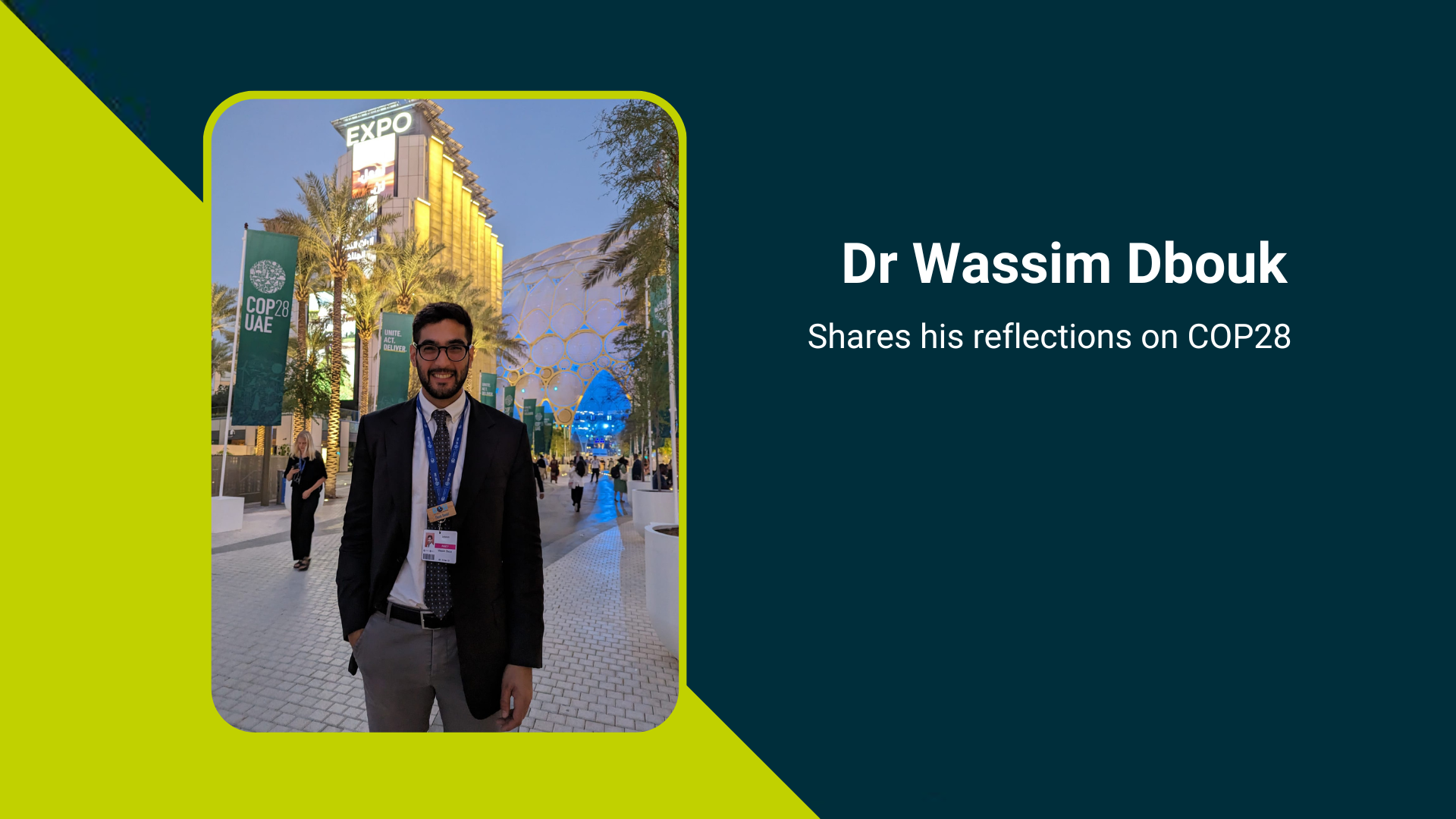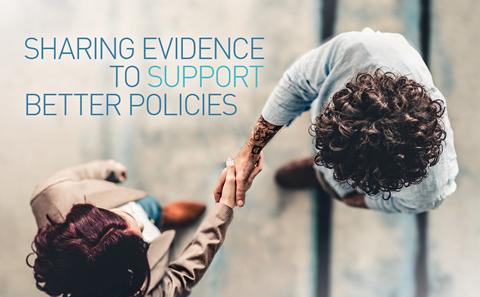
Policy Projects
Learn about PPS led current collaborative projects between the University of Southampton researchers and UK Government and Parliament.
Dr Wassim Dbouk
Public Policy|Southampton and Southampton Marine and Maritime Institute

After being part of the University of Southampton’s delegation to COP26, COP27 and the Bonn Climate Change Conference 2023 (SB58), Dr Wassim Dbouk attended COP28 as part of the Lebanese delegation. In this interview-style blog, he shares his reflections on his experience at the summit, highlighting the different roles which party delegates and observer organisations (including research institutions) play at COPs.
What was my role at COP28?
I was part of the Lebanese delegation’s core negotiation team, and I was also representing the University of Southampton’s marine and maritime community in my capacity as the policy research fellow within the SMMI.
I represented Lebanon at “Informal-Informal” meetings on an agenda item of the Subsidiary Body for Scientific and Technological Advice (SBSTA) on ‘emissions from fuel used for international aviation and maritime transport’, which was mandated by the COP1 decision. It is concerned with the issue of the allocation and control of emissions from international bunker fuels, which requires the SBSTA to take “fully into account” the work of Governments and relevant International Organizations. Thus, under this agenda item, Parties have been discussing reports submitted to the UNFCCC Secretariat by the specialised UN bodies regulating the aviation and shipping industry, namely the International Civil Aviation Organization (ICAO) and the International Maritime Organization (IMO), on their activities to mitigate emissions from bunker fuels. But they have not been deliberating upon the substance of those reports given the divergence on whether the issues they cover fall under the scope of the UNFCCC or need to be aligned with developments thereunder. At COP27 (SBSTA57), Parties had agreed on procedural conclusions which noted that ICAO and IMO representatives were present at the informal consultations under this agenda item, were requested to answer questions from parties and provided some answers to questions. At the SBSTA session in Bonn in June 2023 (SBSTA58), Parties were not able to agree on the wording in the proposed draft conclusions, which lead to pushing the agenda item to SBSTA59 (taking pace during COP28). The ICAO and the IMO made new submissions ahead of SBSTA59 following important outcomes from the Third Conference on Aviation and Alternative Fuels (CAAF/3) and the 80th session of the IMO’s Marine Environment Protection Committee (MEPC80), namely, respectively, the ICAO Global Framework for Sustainable Aviation Fuels (SAF), Lower Carbon Aviation Fuels (LCAF) and other Aviation Cleaner Energies (ICAO Global Framework) and the 2023 IMO Strategy on Reduction of GHG Emissions from Ships. However, there was disagreement over whether the wording of the draft conclusion captures all the parties’ views on the ICAO report submitted to the UNFCCC Secretariat. The latter diverted from the ICAO Global Framework by not clearly conditioning the target to reduce international aviation CO2 emissions by 5% by 2030 upon the principle of common but differentiated responsibility and respective capabilities (CBDR-RC), which was vital for advancing the negotiations around the Framework at CAAF/3 (the ICAO report to the Secretariat merely mentioned the CBDR-RC principle in the report’s appendix). Parties could not reach an agreement over this matter, and it was deferred to SUBSTA60 (June 2024).
I also participated in the sessions where the informal summary report of the 2023 Ocean and Climate Change Dialogue (Bonn 2023) was presented and discussions about what it could entail for the Global Stocktake (GST) process took place. Ultimately, the ocean was mentioned in the Preamble and in several sections of the GST decision, including “Mitigation”, “Adaptation” and most notably, “Guidance and ways forward”, albeit using varying drafting terminology and therefore having different implications/“weight” for parties. Nevertheless, this clearly emphasised the recognition of the crucial role of the ocean in the global efforts to achieve the long-term goals of the Paris Agreement. I also attended several meetings around other agenda items and advocated for the pivotal role which the ocean, including marine biodiversity and coastal habitats should play in our global response to climate change both with regards to mitigation and to adaptation, particularly within the context of the climate change, biodiversity, and nutrition nexus. I also attended several side-events on ocean-related topics, including events on shipping, which brought together stakeholders from different backgrounds and provided great networking opportunities to the benefit of the broader SMMI community.
What is the difference between observer and party delegate?
The United Nations climate change conferences are now among the largest international meetings in the world and provide global forums for multilateral discussions around climate change matters. These conferences serve as the formal meetings of the Conference of the Parties to the United Nations Framework Convention on Climate Change (UNFCCC), to the Kyoto Protocol, and to the Paris Agreement (PA). The meetings of the Conference of the Parties to the UNFCCC, to the Kyoto Protocol and to the PA are respectively referred to as the COP, the CMP, and the CMA. The CMA and the CMP meet annually, during the same period as the COP.
The negotiating process is driven by the Parties to the aforementioned instruments and is concerned with reviewing their implementation and adopting decisions to further develop and implement them. Being a party delegate means that you are representing a State which has signed and ratified the instrument in question during the meetings where negotiations around the items of the agreed agenda for the session take place. This includes meetings of the COP, the CMA, the CMP and of the subsidiary bodies (SUBSTA and SBI) which usually run in parallel with each other. Moreover, Party delegates often informally engage with each other “in the corridors” (as opposed to officially) to test how/if agreements around agenda items could be reached. They do not adopt any decisions but help advancing talks in an informal environment before putting forward proposals to their respective convening body. Observers are invited to attend some of the meetings which are open to Party delegates, and on some occasions, they are also given the opportunity to contribute to the discussions (as in the case of the meetings around the Ocean Dialogue at COP28), without being involved in the decision-making process. There are several categories of observer organisations attending the sessions of the COP and its subsidiary bodies. These include representatives of United Nations secretariat units and bodies, such as UNDP, UNEP and UNCTAD, as well as its specialised agencies and related organisations. Observer organisations also include intergovernmental organizations (IGOs), such as the International Energy Agency (IEA), along with non-governmental organizations (NGOs). Their presence at these meetings is meant to ensure transparency in the proceedings, but priority is given to Party delegates to allow the negotiations to progress. Observers could also be given the opportunity to address the COP and subsidiary bodies in plenary meetings. They are usually not included in official informal group meetings, contact group meetings (unless approved by the Parties), bilateral meetings, negotiating groups coordination meetings, and drafting group meetings. According to the UK Universities Climate Network (UUCN) which the University of Southampton is a member of, Universities and Higher Education Institutions were represented by around 6,000 attendees at COP28. Nearly 2,000 more than in COP26 in Glasgow.
What is the role played by research institutions at COP28?
According to the UK Universities Climate Network (UUCN) which the University of Southampton is a member of, Universities and Higher Education Institutions were represented by around 6,000 attendees at COP28. Nearly 2,000 more than in COP26 in Glasgow. Given the record attendance levels to this COP and the number of side-events taking place across the Blue Zone and sometimes beyond the confines of Expo City Dubai, there was more space given over to academic engagement than in any COP before. These events present invaluable opportunities for research experts to influence party delegates who might be involved in different negotiation streams, but pitches must be incredibly relevant and succinct at the risk of being entirely overlooked. In some meetings which are open to observer organisations, Higher Education Institutions (HEI) can be invited to take the floor and participate in the discussion/make statements which are captured in reports. For example, this was the case during a meeting on the Ocean Dialogue and the closing plenary of the Subsidiary Bodies. COP28 was also a great COP for Early Career Researchers who were particularly active at the events hosted at the various pavilions across the Blue Zone. From the University of Southampton, Florence Atherden attended COP28 as part of the International Cryosphere Climate initiative and focused her activities at the Cryosphere Pavilion. Moreover, the UUCN sponsored a delegation of 10 ECRs who gained invaluable understanding of the COP process and collaborated with climate change experts from around the world. Last but not least, the important role of science and scientists has been echoed throughout the summit, with adopted decisions reiterating the need for action to be informed by “the best available science”. The explicit call on parties to begin transitioning away from fossil fuels in energy systems “in a just, orderly and equitable manner” in the GST decision is a significant achievement in aligning the politics and the negotiations at a climate change summit with the science which unequivocally attributes climate change to CO2 emissions produced by burning fossil fuels.
What was the atmosphere like in a conference such as this?
It is overwhelming, stressful and highly dynamic and competitive. Over the years, the intergovernmental negotiations have become increasingly complex: this year’s COP registered record attendance in every category of delegates, including a doubling of party delegates (from 20,000 to 40,000, more than 10,000 of which as “party overflow”). The venue also seems to only get bigger, with pavilions spread out across many buildings in Expo City Dubai. The spatial planning of the Blue Zone/Green Zone is somewhat symbolic. It gives a strong impression of party delegates and observers working in silos as part of their national or subject-matter interests. Some pavilions were however grouped in larger buildings, such as the Ocean Pavilion. Nonetheless, with such a packed agenda of negotiation meetings and side-events taking place sometimes at overlapping times (which sometimes change with very little notice) at different ends of the venue, it is practically impossible for participants to follow-up with the entire COP process.
I found the negotiation atmosphere interesting. It quickly became evident to me that party delegates receive specialised training in negotiations techniques. Many hold their cards close to their chest and breakthroughs are often made in informal settings. Coordination amongst negotiating groups is not always efficient/democratic as the “diplomatic weight” of countries within those groups vary. Issues of equity in the process arose regularly due to lack of space in negotiating rooms to accommodate delegates from all parties, and sometimes draft texts being developed by facilitators without proper consultation with all parties or being shared with parties with insufficient time for them to effectively review them ahead of meetings. All of this happened under extreme time pressure. Anxiety was prevailing as delegates worked tirelessly to develop draft texts before they were forwarded for final adoption to the COP plenary.
Thoughts on the COP28 outcome
In my view, the negativity in the press reflects the consistent frustration with the slow progress in the global response to climate change since the adoption of the UNFCCC in 1992, particularly when evaluated against the outcomes of the assessment reports of the Intergovernmental Panel on Climate Change (IPCC). I believe that any given COP’s success must be assessed based on the aims it set out to achieve and that, in doing so, we must manage our own expectations by remembering the complex nature of the challenge at hand and the negotiation process around it.
The COP28 Presidency priorities focused on “keeping within reach a globally agreed warming limit of 1.5C, urging agreement on finance, fossil fuels and adaptation”. Consistently, the COP’s primary objectives included accelerating climate mitigation, strengthening adaptation, mobilising climate finance, promoting technology transfer, and fostering international collaboration. To deliver these objectives, COP28 proceedings revolved around specific negotiation priorities which included translating evidence from the Global Stocktake’s (GST) technical phase into actionable steps; operationalising the Loss and Damage Fund agreed at COP27; establishing a framework to guide nations in their efforts under the Global Goal on Adaptation work programme, including action and support targets & monitoring process; establishing a “1.5 degrees-aligned, equitable energy transition package”; scaling up climate finance; the creation of a robust Just Transition Work Programme to accelerate action; etc. The language used in some of the statements by the COP President in the lead up to and during the summit suggested a hierarchy in these priorities with the key tests (based on which the COP’s overall will be assessed) seeming to be focused on delivering the “ambitious stocktake” and being “laser-focused” on “keeping 1.5C in reach”.
It could be said that some “wins” were secured in relation to some of the negotiation priorities. Most notably, this includes the new agreement on the operationalisation of a fund to pay for the loss and damage caused by climate change (without a firm obligation for developed countries to pay into the fund although $770.6m was pledged into the fund by the end of COP28) and the first ever explicit mention of fossil fuels in the GST decision which called on all countries to “transitioning away from fossil fuels…accelerating action in this critical decade” and to contribute to the global tripling of renewable energy capacity and doubling of the rate of energy efficiency improvements by 2030 (which would ultimately depend on legally binding commitments and action taken by States). This signals the beginning of the end of high-income countries’ fossil fuel expansion, which must be met with adequate finance for the energy transition (including in developing countries), but equally and importantly, for adaptation. In this regard, Samoa’s statement on behalf of the Alliance of Small Island States (AOSIS) at the closing plenary with regards to the GST decision reminded us that the climate crisis is in its essence an environmental justice tragedy, and that despite the COP President vowing in his first address to delegates that COP28 would leave “no issue off the table”, it has failed to address the significant shortfall of financial support to the poorest countries that have contributed least to the climate crisis. The failure to reach an agreement on the Global Goal for Adaptation and finance for adaptation at COP28 not only exposes human lives in those countries to the risks of climate change impacts, but widens the divide between the Global North and the Global South as economies in the Global South would continue to suffer the harm caused by climate disasters (as opposed to adapting to climate change and preventing the harm from occurring in the first place) amidst divergence on the application of the principle of common but differentiated responsibilities and respective capabilities.
On a more positive note, good progress was made on nature at COP28, with important references to the Convention on Biological Diversity’s Global Biodiversity Framework and to the importance of protecting and restoring biodiversity, ecosystem integrity, and ecosystem-based approaches to adaptation. Moreover, the Ocean featured in many negotiation streams, with the final version of the GST (which served as the main agreement for COP28) directly calling for “ocean-based action” from States and referring to the importance of protecting and preserving the ocean and coastal ecosystems. Several pledges were also made during COP28, aiming at supporting the protection of marine and coastal ecosystems (eg. the establishment of the Coral Reef Breakthrough).
Hopes for the next COP
I hope I will be involved in the coming COPs as part of the Lebanese delegation and also representing the University of Southampton. My hope is that meaningful breakthroughs would be achieved on the adaptation and just transition agenda and that we build up from the COP28 Declaration on Climate, Relief, Recovery And Peace by acknowledging/recognising the implications of armed conflicts not only on highly vulnerable countries but on any effective global response to the climate emergency.
Find out more about Wassim.

Learn about PPS led current collaborative projects between the University of Southampton researchers and UK Government and Parliament.

Click here to listen to our Policy Podcast series. In each episode we speak to UoS researchers and experts, about their experiences confronting critical issues in the domestic and foreign policies.

Guidance on the many channels available to researchers to engage with policymakers.

Guidance on things to consider in the science to policy process and useful tips in planning and costing your impact activities.